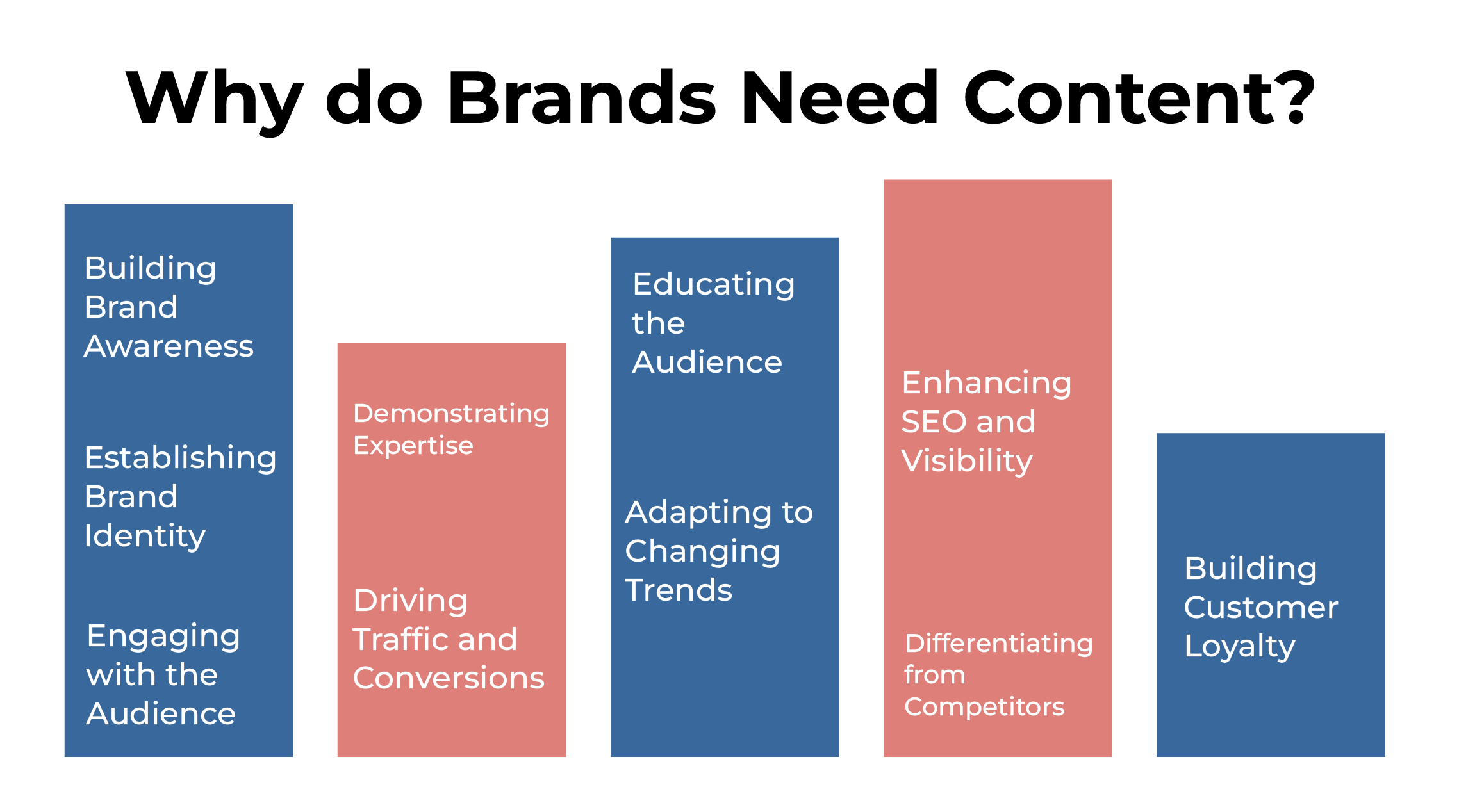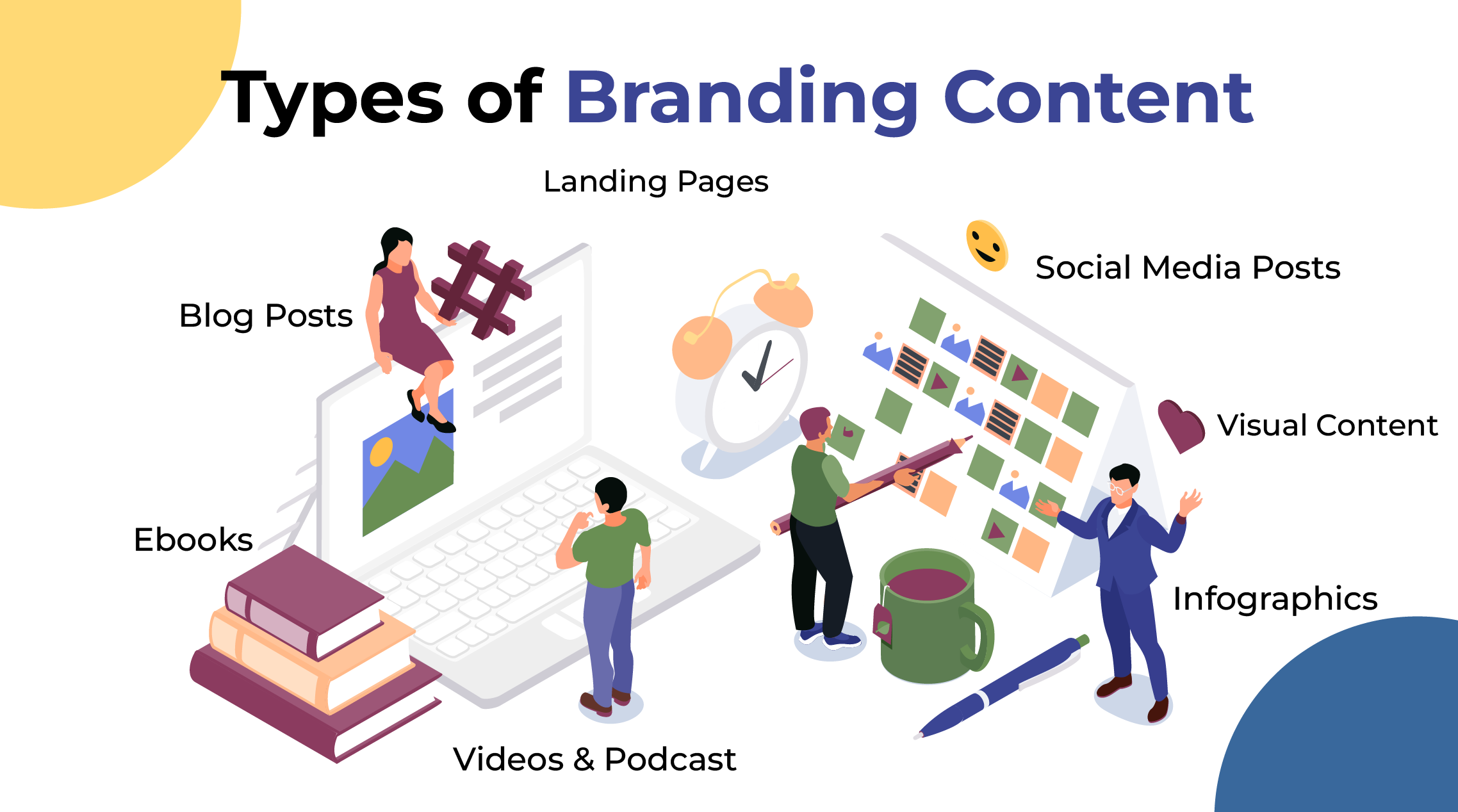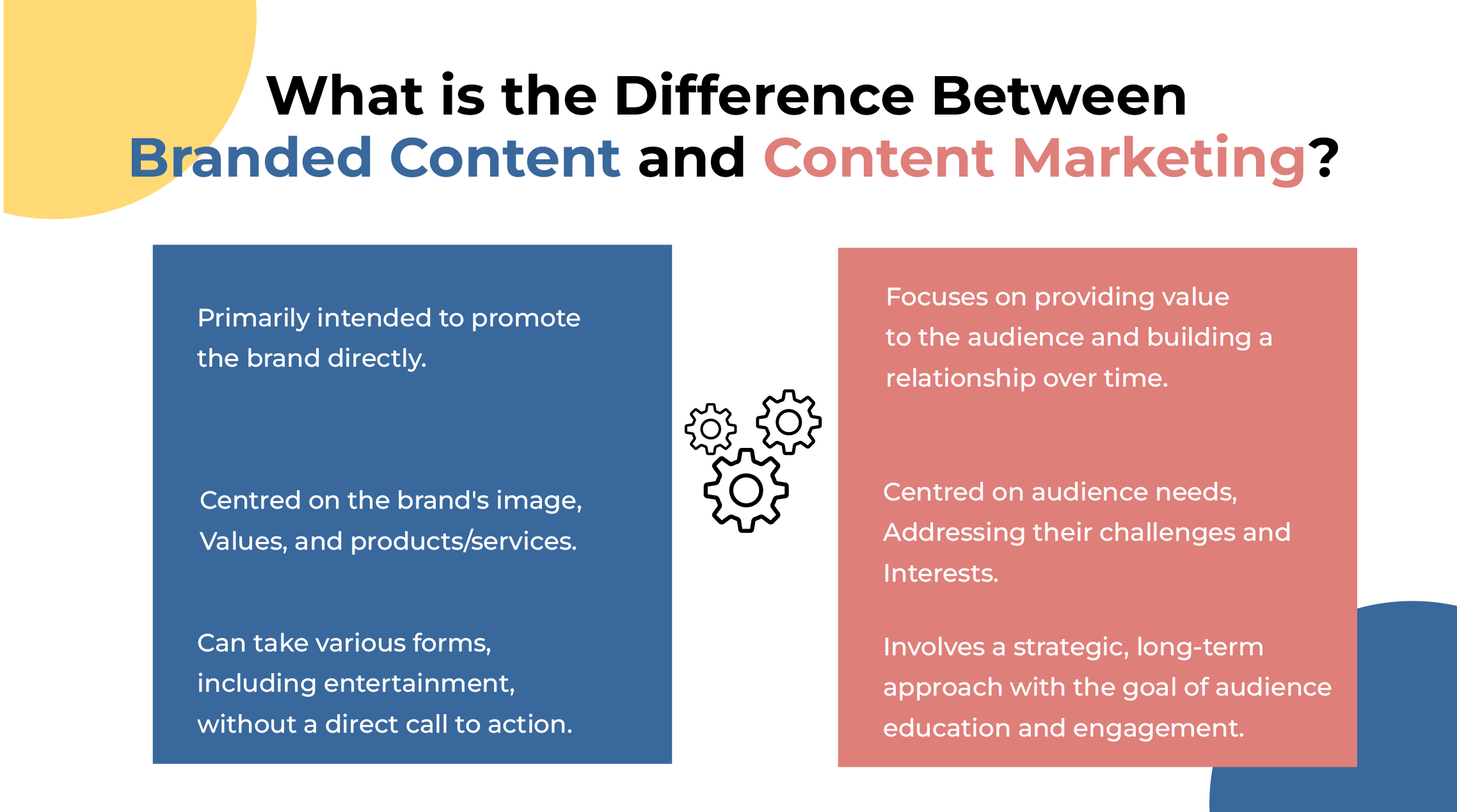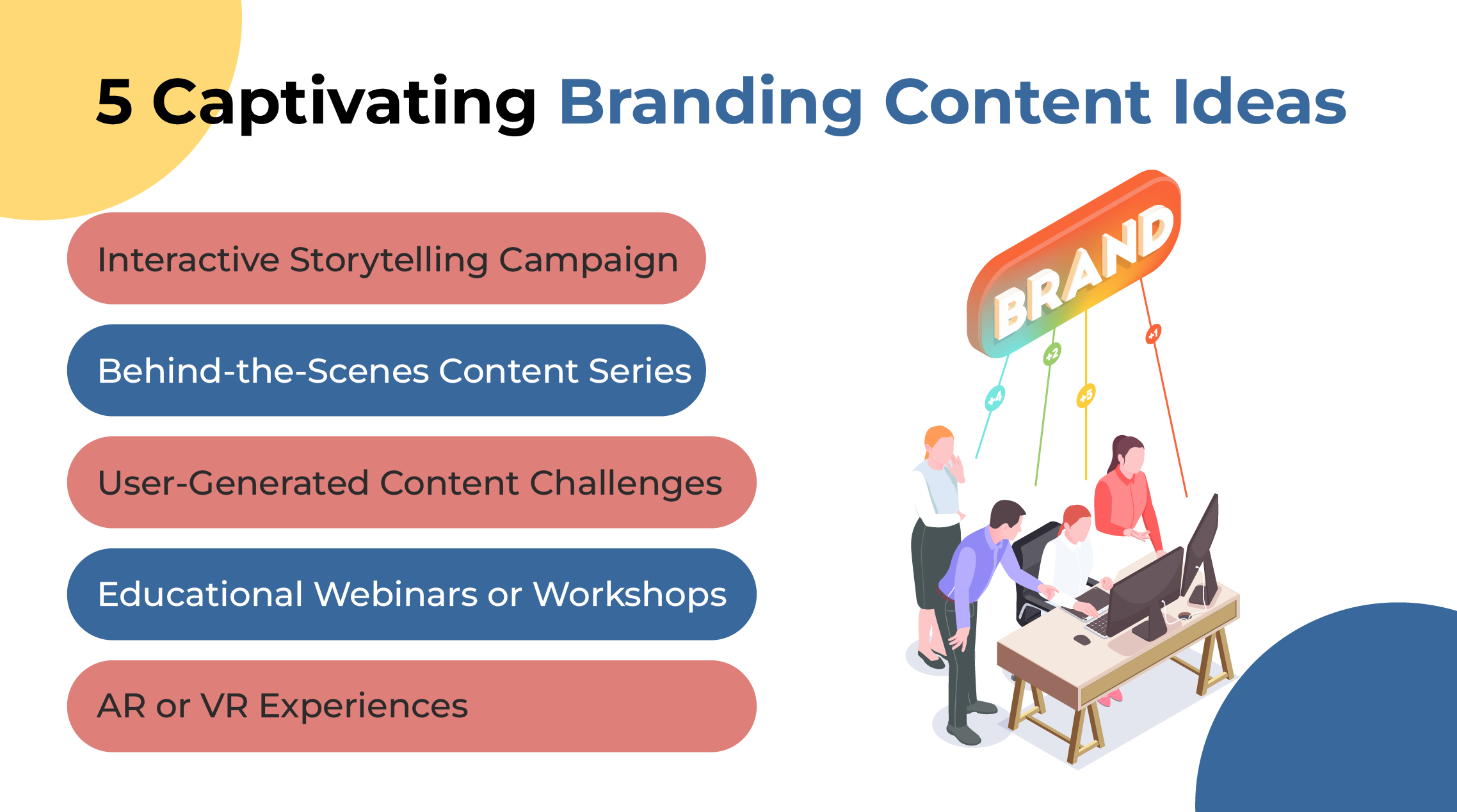Introduction
Where algorithms evolve and trends shift with the digital wind, standing out is no longer an option—it’s a necessity. As we step into the promising landscape of 2024, the journey toward elevating your B2B branding content demands not just innovation but strategic prowess. This isn’t merely about adapting; it’s about leading the pack with a narrative that captivates, engages, and, most importantly, converts.
In this era of information overload, the challenge isn’t just creating content; it’s about crafting an experience that resonates deeply with your target audience. As a seasoned content strategist with over three decades of honing the craft, I’ve witnessed the evolution of content from mere words on a page to a dynamic force that can propel businesses to unprecedented heights.
In this guide, we’ll delve into the intricacies of B2B branding content strategies for 2024, exploring not only the emerging trends but also the timeless principles that form the backbone of successful content. Buckle up as we navigate the ever-evolving landscape of digital marketing, charting a course for your B2B brand to not only survive but thrive in the years ahead.
What is branding?
At its essence, branding transcends the mere concoction of logos, color palettes, and taglines; it’s the soul of your business, the narrative that unfolds with each interaction, and the perception etched into the minds of your audience. In the realm of B2B, branding is the backbone that lends credibility, trust, and identity to your enterprise.
Picture your brand as a living entity—each touchpoint, from a tweet to a meticulously crafted whitepaper, contributes to its persona. Branding is the cohesive thread that weaves these elements into a narrative, an identity that not only distinguishes you from competitors but leaves an indelible mark in the minds of your audience.
In the dynamic landscape of B2B, where relationships and trust are paramount, effective branding is the secret sauce that fosters connection. It’s the intangible force that transforms your products or services from commodities to indispensable solutions. A well-crafted brand is not just a logo or a catchy slogan; it’s an experience, an emotion, and a promise.
As we venture into the strategies and ideas to elevate your B2B branding content in 2024, remember this: branding is the art of storytelling, and your content is the medium through which this story unfolds. It’s the resonance of your values, the embodiment of your mission, and the conduit through which your audience becomes not just customers, but advocates and partners in your journey.
What is branding in content writing?
Branding is the art of infusing every word, every sentence, and every piece of content with the distinctive personality and essence of a brand. It’s not just about conveying information; it’s about creating an immersive experience that resonates with the audience and leaves a lasting impression.
Branding in content writing goes beyond the visual elements of a brand, such as logos and color schemes. It involves capturing the unique voice, values, and identity of a brand through the written word. Whether you’re crafting a blog post, a social media caption, or a comprehensive whitepaper, every piece of content is an opportunity to reinforce the brand’s character and build a connection with the target audience.
Consistency is key in branding through content writing. The tone, style, and messaging should align seamlessly across all platforms and communication channels. This consistency not only builds brand recognition but also fosters trust and reliability. Readers should be able to identify your brand even before seeing the logo, simply by the way the content is presented and the language used.
Moreover, effective branding in content writing involves understanding the target audience deeply. It’s about speaking their language, addressing their pain points, and providing solutions in a manner that feels authentic and relatable. The content becomes a vehicle for building a relationship with the audience, establishing the brand as not just a provider of products or services but as a trusted partner in their journey.
As we explore strategies and ideas to elevate B2B branding content in 2024, keep in mind that every piece of content is an opportunity to reinforce the brand’s identity and forge a meaningful connection with the audience. It’s about turning words into experiences and creating a narrative that leaves a lasting imprint on the minds of your readers.
Need for branding content for B2B SaaS
In the dynamic landscape of B2B SaaS (Software as a Service), where innovation is rapid and competition is fierce, the need for branding content becomes not just a strategic choice but a business imperative. Let’s delve into why effective branding content is crucial for B2B SaaS companies:
- Building trust and credibility
- Communicating complex solutions
- Standing out in a crowded market
- Promoting emotional connections
- Guiding the customer journey
- Adapting to evolving trends
- Encouraging thought leadership
Building trust and credibility
In the world of software solutions, where businesses rely on technology for critical operations, trust is paramount. Strong branding content helps establish credibility by showcasing your expertise, industry knowledge, and the reliability of your SaaS offerings. Trust is the foundation of lasting B2B relationships.
Communicating complex solutions
B2B SaaS often involves intricate and sophisticated solutions. Effective branding content serves as a bridge between technical complexities and the understanding of your target audience. It translates intricate features into tangible benefits, making it easier for potential clients to comprehend the value your SaaS product brings to the table.
Standing out in a crowded market
The SaaS market is saturated with options, and differentiation is key. Your branding content acts as a beacon, guiding potential clients to understand what sets your solution apart. Whether it’s a unique selling proposition, innovative features, or exceptional customer service, your brand story helps you stand out amid the competition.
Promoting emotional connections
While B2B transactions are often viewed as rational decisions, emotions play a significant role. Effective branding content taps into the emotional aspects of decision-making, creating a connection beyond the functional benefits of your SaaS product. This emotional resonance can lead to long-term relationships and customer loyalty.
Guiding the customer journey
The B2B SaaS customer journey is multifaceted, involving various touchpoints. Your branding content guides prospects through the stages of awareness, consideration, and decision-making. It provides the information and assurance needed at each step, nurturing leads into satisfied customers.
Adapting to evolving trends
The SaaS industry evolves rapidly with technological advancements and changing customer needs. Your branding content serves as a flexible tool to adapt to these shifts. It allows you to communicate how your SaaS solution stays at the forefront of industry trends and continuously adds value to clients.
Encouraging thought leadership
B2B SaaS companies are often at the forefront of innovation. Through thoughtfully crafted branding content, you can position your brand as a thought leader in the industry. This not only enhances your reputation but also attracts businesses seeking cutting-edge solutions.
Why do brands need content?

Brands need content for a multitude of reasons, each contributing to the overall success and longevity of the brand. Here are key reasons why content is an indispensable asset for brands:
Building Brand Awareness:
Content serves as the vehicle for introducing your brand to the world. Through blogs, social media posts, videos, and other content formats, you can increase your brand’s visibility and create awareness among your target audience.
Establishing Brand Identity:
Content is instrumental in shaping and communicating your brand identity. The tone, style, and messaging in your content contribute to how your brand is perceived by the audience. Consistent and well-crafted content helps define your brand personality.
Engaging with the Audience:
Content provides a platform for two-way communication between the brand and its audience. Engaging content, whether in the form of social media interactions, blog comments, or interactive campaigns, fosters a sense of community and builds relationships.
Demonstrating Expertise:
Content allows brands to showcase their industry knowledge and expertise. Through informative articles, whitepapers, and case studies, brands can position themselves as authorities in their respective fields, gaining the trust of their audience.
Driving Traffic and Conversions:
Quality content is a powerful tool for attracting and retaining an audience. Whether through search engine optimization (SEO), social media, or other channels, content drives traffic to your digital platforms and plays a crucial role in converting visitors into customers.
Educating the Audience:
Brands often operate in industries with complex products or services. Content serves as an educational tool, helping your audience understand the value and functionality of what you offer. This educational content can range from how-to guides to in-depth product explanations.
Adapting to Changing Trends:
The business landscape evolves, and so do consumer preferences. Content allows brands to stay agile and adapt to changing trends. By consistently producing relevant and timely content, brands can remain top-of-mind and responsive to shifts in the market.
Enhancing SEO and Visibility:
Search engines favor fresh, relevant, and high-quality content. Regularly updating your website with valuable content improves its search engine ranking, increasing visibility and making it easier for potential customers to find your brand online.
Differentiating from Competitors:
Content is an opportunity to showcase what makes your brand unique. Whether through storytelling, brand narratives, or highlighting your values, content helps differentiate your brand from competitors in a crowded marketplace.
Building Customer Loyalty:
Consistent and valuable content builds a loyal audience. Brands that provide ongoing value through their content create a community of engaged followers who are more likely to become repeat customers and brand advocates.
Content is the bridge between your brand and your audience. It’s the means through which you tell your story, connect with customers, and demonstrate the value your brand brings. In a digital age where information is abundant, strategic and compelling content is not just an asset—it’s a necessity for brands looking to thrive and leave a lasting impact.
Types Of Branding Content

The landscape of branding content is diverse, offering various types of content to cater to different purposes, channels, and audience preferences. Here’s a comprehensive list of types of branding content that brands can leverage:
Blog Posts:
Regularly publishing blog posts allows brands to share industry insights, thought leadership, and updates. Blogs are versatile and can cover a range of topics to engage a broad audience.
Social Media Posts:
Short-form content on platforms like Facebook, Twitter, Instagram, and LinkedIn allows brands to connect with their audience, share updates, and participate in conversations.
Infographics:
Visual representations of information are highly shareable and easy to understand. Infographics are effective for presenting statistics, data, or complex concepts in a visually appealing manner.
Videos:
Video content is increasingly popular. Brands can create product demos, explainer videos, interviews, or even vlogs to engage audiences on platforms like YouTube and social media.
Podcasts:
Podcasts provide an auditory experience, allowing brands to share in-depth discussions, interviews, and insights. They are convenient for audiences who prefer consuming content while on the go.
eBooks and Whitepapers:
Long-form content like eBooks and whitepapers is ideal for in-depth exploration of topics. Brands can use these formats to showcase expertise and provide valuable resources.
Case Studies:
Sharing real-world examples of how your products or services solved a problem for a client adds credibility to your brand. Case studies are effective for demonstrating the practical application of your offerings.
Email Newsletters:
Newsletters allow brands to maintain regular communication with their audience. They can share updates, curated content, and exclusive offers directly to subscribers’ inboxes.
Webinars:
Hosting webinars enables brands to engage with their audience in real-time. It’s an effective format for sharing knowledge, conducting product demonstrations, and answering questions.
Interactive Content:
Quizzes, polls, surveys, and interactive graphics encourage audience participation. Interactive content is not only engaging but also provides valuable insights into audience preferences.
User-Generated Content (UGC):
Encouraging your audience to create and share content related to your brand can be a powerful strategy. UGC includes customer testimonials, reviews, and social media posts featuring your products or services.
Visual Content:
Apart from infographics and videos, visual content includes images, illustrations, and graphics that enhance the overall aesthetic appeal of your brand across various platforms.
Landing Pages:
Specifically designed pages on your website, such as product pages or campaign landing pages, serve as focused content to drive conversions and provide detailed information.
Product Descriptions:
The content describing your products or services on your website or in catalogs is crucial for informing potential customers and influencing their purchase decisions.
Press Releases:
Announcements and updates can be formalized through press releases. They are essential for communicating major developments within your company.
Social Proof:
Testimonials, reviews, and endorsements from satisfied customers contribute to building trust. Incorporate social proof across various touchpoints to reinforce your brand’s credibility.
Interactive Product Tours:
Provide a virtual tour of your product or service, allowing users to explore features and benefits interactively.
Surveys and Polls:
Collect feedback and insights from your audience through surveys and polls. This not only engages your audience but also helps in refining your products or services.
Employee Spotlights:
Highlighting the people behind your brand adds a personal touch. Employee spotlights humanize your brand and showcase the expertise and passion within your team.
FAQs and Knowledge Base:
Creating content that addresses common questions and provides valuable information helps users find answers and demonstrates your commitment to customer support.
By incorporating a mix of these types of branding content into your strategy, you can create a dynamic and engaging brand presence that resonates with your audience across various platforms and channels.
How Do You Write Branding Content?
Writing effective branding content requires a strategic approach that aligns with your brand identity, values, and goals. Here’s a step-by-step guide on how to write compelling branding content:
Define Your Brand Voice and Tone:
Clearly articulate your brand voice and tone. Are you authoritative, friendly, or innovative? This foundational step ensures consistency across all content and helps in creating a distinct brand personality.
Understand Your Audience:
Comprehensive knowledge of your target audience is crucial. Understand their needs, pain points, and preferences. Tailor your content to resonate with their interests and language.
Establish Brand Messaging:
Develop key brand messages that encapsulate your value proposition. These messages should be clear, concise, and memorable, forming the basis for all your content.
Craft a Compelling Brand Story:
Narratives are powerful tools for connecting with audiences emotionally. Develop a compelling brand story that communicates your origin, mission, and the journey you share with your customers.
Create a Content Strategy:
Outline a content strategy that aligns with your business objectives. Consider the types of content (blog posts, videos, social media, etc.) and the topics that will resonate with your audience.
Use Visual Elements:
Incorporate visual elements that complement your written content. This includes logos, images, infographics, and other design elements that reinforce your brand aesthetics.
Focus on Value:
Ensure that your content provides value to your audience. Whether it’s educational, entertaining, or informative, every piece of content should contribute positively to the user experience.
Be Authentic:
Authenticity builds trust. Be genuine and transparent in your communication. Avoid using jargon or marketing speak that may come across as insincere.
Optimize for SEO:
Implement search engine optimization (SEO) techniques to enhance the discoverability of your content. Use relevant keywords naturally, create compelling meta descriptions, and ensure your content is easily accessible.
Maintain Consistency:
Consistency is key to effective branding. Ensure that your content aligns with your brand guidelines, including colors, fonts, and messaging. This consistency fosters recognition and trust.
Encourage Engagement:
Prompt audience engagement through calls-to-action (CTAs), social media shares, comments, and other interactive elements. Actively respond to audience feedback and participate in conversations.
Tell Customer Stories:
Feature customer testimonials, case studies, or success stories. This not only provides social proof but also humanizes your brand and showcases the practical impact of your products or services.
Keep it Concise and Clear:
Attention spans are limited, so keep your content concise and clear. Get to the point quickly, and make sure your audience can easily grasp the main message.
Adapt to Platform Dynamics:
Tailor your content for different platforms. Each social media channel or website may have distinct user behaviors and expectations. Adapt your content to fit these dynamics.
Measure and Analyze:
Regularly analyze the performance of your branding content. Use analytics tools to assess engagement, conversions, and other relevant metrics. Adjust your strategy based on the insights gained.
Remember, effective branding content is an ongoing process. Stay attuned to industry trends, monitor audience feedback, and continuously refine your approach to ensure your content remains relevant and impactful.
What Is The Difference Between Branded Content And Content Marketing?

Branded content and content marketing are related concepts, but they have distinct focuses and purposes. Understanding the differences between them is crucial for developing a comprehensive content strategy. Here’s a breakdown of each term:
Branded Content:
1. Definition:
Branded content refers to content that is specifically created to promote a brand. It is content produced or commissioned by a brand, often with the primary goal of showcasing the brand’s values, personality, or products/services.
2. Characteristics:
Promotional Focus: The primary aim of branded content is brand promotion. It’s crafted to create positive associations with the brand in the minds of the audience.
Entertaining or Informative: Branded content can take the form of entertainment or informational pieces. It is not overtly promotional but subtly integrates the brand’s messaging.
3. Examples:
Web Series: A company creating a web series that features its products/services in a storyline.
Sponsored Content: Paid articles or videos on third-party platforms that highlight the brand.
4. Goal:
Brand Awareness and Perception: The main goal is to enhance brand awareness, shape brand perception, and connect emotionally with the audience.
Content Marketing:
1. Definition:
Content marketing is a broader approach that involves creating and distributing valuable, relevant, and consistent content to attract and engage a target audience. It goes beyond promotion and aims to provide value to the audience.
2. Characteristics:
Audience-Centric: Content marketing is focused on the needs and interests of the target audience. It aims to solve problems, answer questions, and provide information relevant to the audience.
Strategic and Long-Term: Content marketing is a strategic, long-term approach to building a relationship with the audience. It’s not just about immediate sales but about nurturing trust over time.
3. Examples:
Blog Posts: Regularly publishing informative blog posts that address industry-related topics.
How-to Guides: Creating comprehensive guides that help users solve problems or achieve specific goals.
4. Goal:
Audience Engagement and Trust: Content marketing aims to build a loyal audience by consistently delivering valuable content. It focuses on establishing the brand as a trusted authority in its industry.
Key Differences:
1. Intent:
Branded Content: Primarily intended to promote the brand directly.
Content Marketing: Focuses on providing value to the audience and building a relationship over time.
2. Focus:
Branded Content: Centered on the brand’s image, values, and products/services.
Content Marketing: Centered on audience needs, addressing their challenges and interests.
3. Approach:
Branded Content: Can take various forms, including entertainment, without a direct call to action.
Content Marketing: Involves a strategic, long-term approach with the goal of audience education and engagement.
While branded content is a subset of content marketing, content marketing is a broader strategy that encompasses a variety of content types and focuses on building relationships and providing value to the audience over time. Branded content, on the other hand, is more explicitly tied to promoting the brand and shaping its image.
5 Captivating branding content ideas
Creating captivating branding content requires a blend of creativity, relevance, and a deep understanding of your target audience. Here are five engaging branding content ideas to elevate your brand presence:

- Interactive storytelling campaign
- Behind-the-scenes content series
- User-generated content challenges
- Educational webinars or workshops
- AR or VR experiences
1. Interactive storytelling campaign
Develop an interactive storytelling campaign that unfolds gradually across various platforms. Incorporate elements like quizzes, polls, and user-generated content to involve your audience actively. This approach not only tells your brand story but also encourages audience participation.
2. Behind-the-scenes content series
Provide a glimpse behind the curtain by creating a series of behind-the-scenes content. This could include videos, photos, or blog posts showcasing the daily operations, team members, and the creative process. Humanizing your brand fosters a sense of connection and authenticity.
3. User-generated content challenges
Launch a creative challenge encouraging your audience to generate content related to your brand. Whether it’s a photo contest, a video challenge, or a hashtag campaign, this approach not only generates valuable user-generated content but also strengthens community engagement.
4. Educational webinars or workshops
Share your industry knowledge by hosting educational webinars or virtual workshops. Address relevant topics, provide valuable insights, and position your brand as an authority in the field. This not only engages your audience but also establishes trust and credibility.
5. AR or VR experiences
Leverage augmented reality (AR) or virtual reality (VR) to create immersive brand experiences. Whether it’s a virtual tour of your products, an interactive demo, or a branded AR filter on social media, these technologies can captivate your audience and leave a lasting impression.
7 Branding content strategies to try in 2024
Digital marketing is always changing, and with it comes fresh opportunities and challenges for brands. Here are seven branding content strategies you should consider trying out in your marketing plan for 2024:
- Interactive content experience
- Personalized content journeys
- Authentic User-Generated Content (UGC)
- Visual and immersive storytelling
- Sustainability and social responsibility messaging
- Cross-platform integration
- Voice search optimization
Interactive content experience
Use interactive content to draw in and captivate your audience. Think quizzes, polls, surveys, and interactive infographics. These not only boost user engagement but also give you valuable insights into what your audience likes and how they behave.
Personalized content journeys
Tailor your content to individual users through personalized content journeys. Use data and analytics to get a clear picture of user behavior, preferences, and demographics. This way, you can deliver content that directly addresses the unique needs and interests of your audience.
Authentic User-Generated Content (UGC)
Encourage and highlight genuine UGC that showcases real experiences with your brand. User testimonials, reviews, and social media posts offer social proof and build trust. Run campaigns that motivate users to share their stories and become brand advocates.
Visual and immersive storytelling
Dive into visually rich and immersive storytelling. Utilize technologies like virtual reality (VR) or augmented reality (AR) to create captivating brand narratives. Visual content, including videos, infographics, and interactive graphics, can effectively convey your brand message.
Sustainability and social responsibility messaging
Integrate sustainability and social responsibility into your brand narrative. Consumers today value brands that align with their ethical and environmental beliefs. Highlight your commitment to these causes with content that showcases your sustainability efforts and positive social impact.
Cross-platform integration
Ensure your content strategy works seamlessly across multiple platforms. Maintain consistency in messaging and aesthetics across social media, your website, email campaigns, and more. This unified approach reinforces your brand identity and improves the overall user experience.
Voice search optimization
With more people using voice-activated devices, make sure your content is optimized for voice search. Create content that matches natural language queries and conversational search patterns to keep your brand discoverable in the age of voice search engines.
Conclusion
Remember that effective branding content is more than just a marketing tool; it’s a vehicle for building relationships, fostering trust, and shaping perceptions. Embrace interactive experiences, personalized journeys, and immersive storytelling to captivate your audience. Leverage the power of user-generated content to showcase authenticity, and infuse sustainability and social responsibility into your brand narrative to resonate with conscious consumers.
A unified, cross-platform approach ensures your brand message remains consistent, reinforcing identity across various touchpoints. As voice search becomes prevalent and search engine algorithms evolve, optimizing your content for these changes will be crucial for maintaining visibility.
In this ever-evolving landscape, the ability to adapt, experiment, and measure results will be your greatest asset. Stay attuned to emerging trends, listen to your audience, and let your brand story unfold authentically. As you implement these strategies, remember that the heart of effective branding content lies in creating meaningful connections and leaving a lasting impact on the minds and hearts of your audience. Here’s to a successful and innovative journey in the realm of branding content in 2024 and beyond.
Ready to redefine your brand narrative? Dive into our 2024 content strategies and transform your B2B branding. Unleash the power of immersive storytelling, harness user-generated content, and optimize for voice search. Elevate your brand to new heights – start crafting compelling narratives today. Let’s embark on this journey together. Embrace the future of branding content now!



